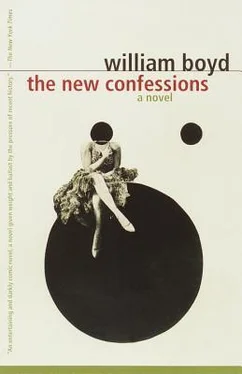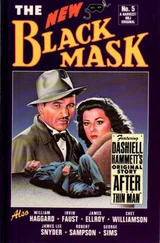I go into the main town, the port, to see Eddie’s lawyer about getting the pool filled. The central square is shabbily elegant, paved with white stone and lined with mature fragrant oleanders. The yellowing stucco buildings around it have tall windows with shutters and wrought-iron balconies. At one end there is an amusing baroque statue of two heavily armed, plumed soldiers wrestling with the flag of liberty.
Everywhere the tourists mill about. Inside his hot office the lawyer is diplomatic. He procrastinates. He apologizes. What can he do? Perhaps at the end of the tourist season …
I leave and join gaudy visitors to our island. I find my favorite café overlooking the harbor and after waiting no more than ten minutes I secure a seat. I eat some ice cream — pistachio, always pistachio — and drink a coffee. I think about Ulrike. She’s a charming girl. The tan she has now suits her. She exudes health and a settled happy confidence in her life or work. I try to picture her boyfriend, the cineast. I see a beard, a checked shirt, a name like Rudi or Rolf. Everything seems fine, Ulrike, but tread carefully. Remember the Uncertainty Principle. It governs the molecules we’re made up of. A little of it is going to penetrate our human world. If a fig tree root can make it through a solid concrete wall, what is going to stop the Uncertainty Principle? Look at my life — lived in unswerving devotion to its capricious edicts.
I stop. I’m getting depressed. I look up and at that moment a tourist bus goes by. And there at a window pointing at the attractions of our picturesque harbor is a man I know. An American. The bus passes; my sudden fear sizzles on, like spit on a hot skillet. Reassurance is slow to return. Relax, I say to myself, it could be a coincidence. It must be. It might not even be him at all. He never saw you, and anyway, nobody knows you are here.
In the summer of 1730, Mme. de Warens quit Annecy temporarily for Paris, leaving Jean Jacques behind. He had a pleasant time in her absence, dallying with young women, several of whom, or so he claimed in his Confessions , were in love with him. On one particularly beautiful day he went for a walk in the country. In a green valley beside a stream he came across two girls who were having difficulty leading their horses across. Rousseau had met one of the girls before — a Mlle. de Graffenried — and was introduced to her by the other — Mile. Galley. They were both pretty, especially Mlle. Galley, who was “both small and well developed at an age when a girl is most beautiful.” Rousseau helped them both across the stream and the girls insisted on his accompanying them for the rest of the day. They were going to the Château de la Tour at Thônes, a large farmhouse that belonged to Mlle. Galley’s family.
They duly arrived at the château and enjoyed a late lunch in the kitchen. Saving their coffee and cream cakes for later, they decided to round off their meal by going into the chateau’s cherry orchard to pick the ripe fruit. Rousseau climbed the trees and threw down cherries to the girls, who teasingly threw the pits back up at him. A flirtatious game ensued. Then “Mlle. Galley, with her apron held forward and her head thrown back, presented such a good target and I threw so well, that a bunch of cherries fell between her breasts. What laughter! I said to myself, ‘If only my lips were cherries I would gladly throw them there.’ ”
But nothing happened. It was an idyll, vibrant with sexual intimations and unrealized potential. As you can imagine, this particular episode had burned itself into my mind when I read it in my barren cell at Weilburg. And remember I read it as a virgin (my two girls were Huguette and Dagmar) and at the time it actually occurred Jean Jacques had been a virgin too. He never forgot that day in the cherry orchard. For him it was a moment, he realized later, which proved that the erotic sensuality of innocence is often more powerful than the carnal pleasures of adulthood.
I filmed the entire day just as Rousseau had related it. I cast the two girls locally, searching touring theater groups and music halls in Grenoble, Nice and Lyons. It was their appearance that was important, not their acting ability — I had no need for sophisticated, worldly actresses. All they had to do was look right, giggle and flirt. Karl-Heinz was a gauche monster of ardent frustration, positively deformed with the competing pressures of desire and shyness. In our orchard we cut out the center of one tree and mounted a camera platform there. We used embossed film for the moment Mlle. Galley’s breasts “catch” the bunch of cherries. It was during this week that I saw a further potential in the Tri-Kamera. I realized that it need not be employed solely for creating one single long, stretched image — it could just as easily make three separate ones. Throughout one exhausting evening Horst and I worked out with the aid of diagrams a sequence of massive close-ups using the embossed film. The actors were baffled as we thrust the cameras to within inches of their faces from every possible angle, pausing between shots to consult sheaves of notes and scribbled drawings. The resulting sequence is breathtaking in its latent erotic power, as those who saw it on the three screens testified. Let me take you through it.
Everything in the episode, in terms of filming, proceeds orthodoxly. The encounter at the stream, the ride to the château, the meal in the kitchen. Then, as the trio walk to the cherry orchard, the curtains in the cinema draw back to reveal the two angled screens adjacent to the main one. The two auxiliary projectors start up and suddenly we have three separate images. Three heads in view: Jean Jacques, flanked by Mlles. Graffenried and Galley. We see covert glances pass among them. The two girls look up on either side as Jean Jacques climbs the tree in the center screen. Then the contours shift and firm as the embossed film runs through the projector. The hanging clump of cherries seems to take on the form of three-dimensional fruit. The perfect pallor of the girls’ faces and shoulders seems cast in plaster relief against the leafy background. We look down with Jean Jacques at the two delightful lasses gazing up at him. The girls eat the cherries, spit the stones into their hands and throw them back at Jean Jacques, who ducks the gentle hail.
Then the center screen is filled by Mlle. Galley looking up, apron held out to catch more fruit. Jean Jacques’s face is on one side screen as he plots his revenge; on the other, his hand plucking a bunch of cherries. Center screen: we move in slowly on Mlle. Galley’s breasts, the low cut of her gown, the pressure, on either side, of her arms forcing them ever so slightly together, the swell and subsidence of her excited breathing, the soft deep shadow of her cleavage. Jean Jacques’s hand throws. Center screen, the cherries land. Lips, cherries, lips. Eyes, cherries, eyes. Then three laughing mouths. We pull back. In the center Jean Jacques’s laughter disguises his agonized face. The side screens dim; the curtains roll back to cover them.
It works magnificently. At the premiere the audience was in an uproar. The planning of it all was painstakingly difficult. (I must pay tribute to Mlle. Sadrine Storri, a burlesque dancer from Lyons who disappeared back into obscurity after the film, who played Mlle. Galley. She showed admirable patience and good humor as I, standing on a chair above her, dropped dozens of cherry bunches onto her bosom, Horst’s camera whirring twelve inches away.) Of course my delight and pride in this scene was delayed. We were working blind. I had to wait many months before I saw the sequence run on three full-sized screens. For myself, and I speak with total honesty and objectivity, I think it represents the most complete and effective blend of technique and content in the entire movie. Embossed film and the Tri-Kamera were the perfect devices to reincarnate the tender eroticism of that warm afternoon near Annecy. Add to that the audacious use of massive close-ups of lips and eyes, dark glossy cherries and pale heaving breasts … overpowering images. My close-ups in The Confessions: Part I were the largest ever witnessed on the screen up to that time (larger than Eisenstein’s for sure) and — this is what makes me particularly proud — not a caption in sight.
Читать дальше












